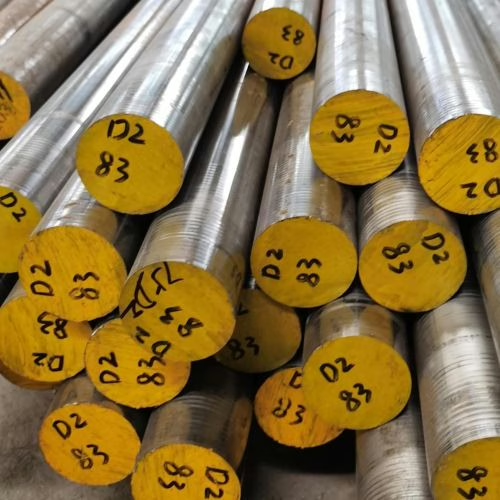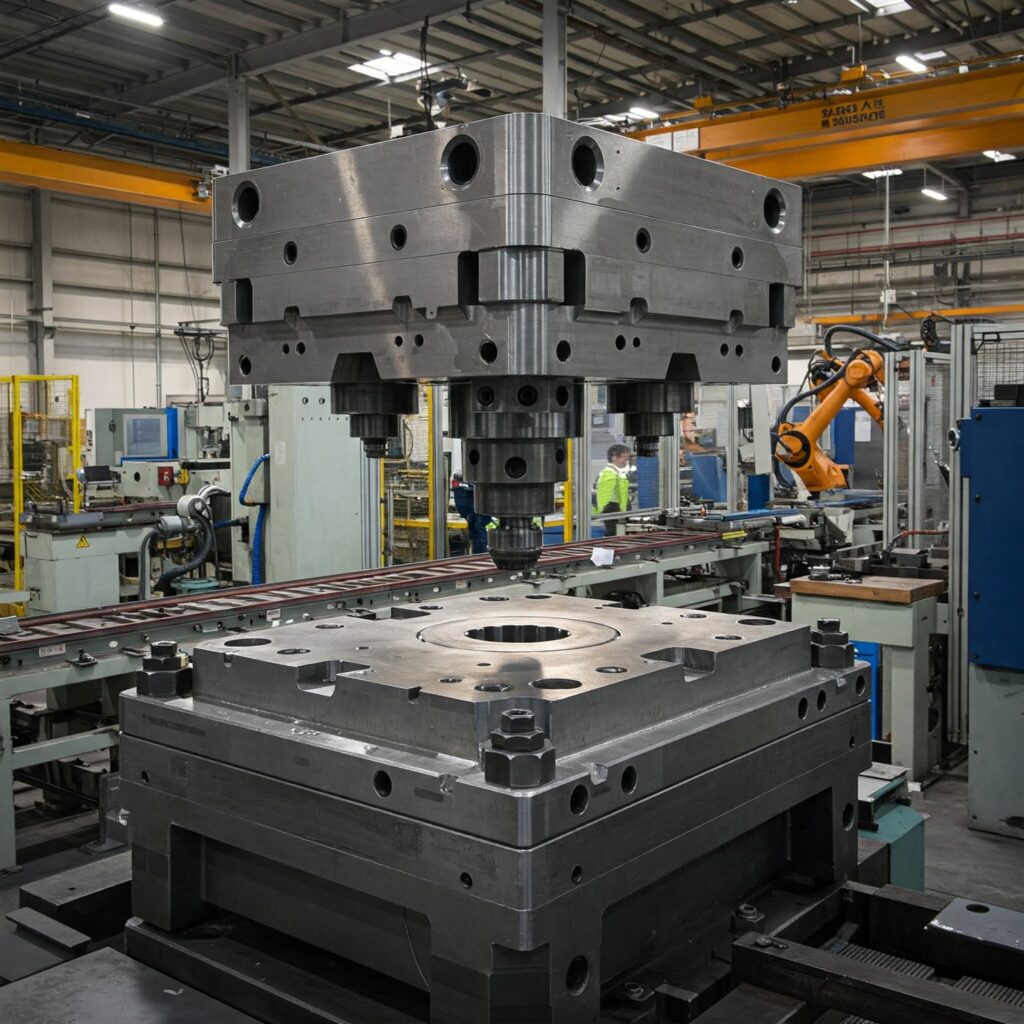Tiempo estimado de lectura: 7 minutos
Conclusiones clave
- O1 tool steel and D2 are both cold-work tool steels, but they have distinct chemical compositions and applications.
- O1 exhibits better machinability and higher toughness, while D2 offers superior wear resistance and dimensional stability.
- In terms of heat treatment, O1 is oil-hardening and prone to cracking, whereas D2 is air-hardening with minimal deformation risks.
- Applications of O1 include general purpose tools, while D2 is preferred for high-wear tooling requiring prolonged usage.
- Selecting between O1 tool steel Vs D2 depends on whether you prioritize ease of machining or enhanced wear life.
Tabla de contenido
Acero para herramientas O1 vs. D2: Acero para herramientas O1 y Acero para herramientas D2 Ambos son aceros para herramientas de trabajo en frío ampliamente utilizados, pero poseen características distintivas que los hacen adecuados para diferentes aplicaciones. Una comparación detallada revela sus fortalezas y debilidades.


O1 tool steel Vs D2: Chemical Composition
| Elemento | Acero para herramientas O1 (%) | Composición del acero D2 (%) |
| Carbono (C) | 0.85 – 1.00 | 1.40 – 1.60 |
| Cromo (Cr) | 0.40 – 0.60 | 11.00 – 13.00 |
| Manganeso (Mn) | 1.00 – 1.40 | 0.10 – 0.60 |
| Vanadio (V) | 0.15 – 0.30 | 0.50 – 1.10 |
| Molibdeno (Mo) | – | 0.70 – 1.20 |
| Tungsteno (W) | 0.40 – 0.60 | – |
| Silicio (Si) | 0.10 – 0.50 | 0.10 – 0.60 |
| Fósforo (P) | ≤ 0.03 | ≤ 0.03 |
| Azufre (S) | ≤ 0.03 | ≤ 0.03 |
O1 tool steel Vs D2: Mechanical Properties
- DurezaEl acero O1 y el acero D2 tienen una dureza de trabajo similar. El típico Dureza del acero O1 es de 58–60 HRC. Dureza del acero D2 Tiene una dureza de 58-61 HRC y puede alcanzar 60-62 HRC mediante tratamiento térmico, incluso hasta 63-64 HRC cuando se produce mediante procesamiento de pulvimetalurgia (P/M). Generalmente, Acero O1 dureza Rockwell es ligeramente inferior al de D2.
- Fuerza. O1 has a yield strength of 829 MPa (758 MPa UTS). Its compression yield strength was higher than that of D2 steel. The yield strength of D2 is 411 MPa (350 MPa UTS), and the tensile strength (UTS) is 758 MPa.
- DurezaEn comparación con el acero O1, el acero D2 presenta menor tenacidad. La gran cantidad de carburos en el acero D2 reduce su tenacidad.
- Ductilidad/PlasticidadEl acero O1 presenta mayor ductilidad que el acero D2. El acero O1 presenta una estrangulación significativa antes de la fractura, con una reducción de área calculada de aproximadamente 19,71 TP3T. El acero D2 prácticamente no mostró estrangulación antes de la fractura, con una reducción de área de 1,31 TP3T.
- Resistencia al desgaste/Resistencia a la abrasión. D2 has better wear resistance compared to O1. O1 steel has moderate wear resistance, while D2 steel has very high wear resistance. This is because the high carbon and chromium content in D2 steel produces a large amount of M7C3-type chromium-rich carbides.
- Estabilidad dimensional/DistorsiónEn comparación con otros aceros para herramientas, el acero D2 presenta la mejor estabilidad dimensional durante el tratamiento térmico, aunque el acero O1 también presenta cambios dimensionales mínimos durante el temple en aceite. El acero D2 se templa principalmente al aire, con una expansión o contracción de aproximadamente 0,0005 pulgadas por pulgada.
- Maquinabilidad/rectificableEl acero O1 presenta una excelente maquinabilidad, con una calificación de 90 en comparación con 100 para el acero al carbono 1%. El acero D2 presenta una maquinabilidad particularmente baja, con una calificación de 45 en comparación con 100 para el acero al carbono 1%. Obviamente, el acero O1 tiene una maquinabilidad mucho mejor.
Heat Treatment Comparison
O1 is an oil-hardening steel, also known as oil-quenched steel, which is rapidly immersed in oil for cooling after being heated to the austenitizing temperature. This rapid oil-cooling process subjects the steel to significant thermal shock. Consequently, O1 presents moderate quenching safety risks during hardening, being prone to cracking due to thermal shock and relatively large dimensional changes or deformation risks. Compared to air-hardening steels, O1 exhibits poorer dimensional stability. Expansion during quenching is estimated at approximately 0.0015 mm/mm. Additionally, O1 is prone to decarburization during heat treatment, where surface carbon content is lost, resulting in insufficient surface hardness.
D2 is a wind-hardening steel, also known as air-hardening steel. When cooled from its austenitizing temperature, it achieves its full hardness simply by cooling naturally in still air. Because D2 contains a high proportion of alloying elements, these elements significantly slow the rate of microstructural transformation within the steel. Air cooling is an exceptionally slow and gentle cooling process. Consequently, D2 exhibits exceptionally high safety during hardening and is extremely resistant to cracking. During heat treatment, D2 demonstrates minimal deformation, with a very low expansion or contraction rate of approximately 0.0005 mm/mm. Due to its outstanding dimensional stability, D2 is the material of choice for manufacturing precision molds with complex geometries and extremely tight tolerances.
| Característica | Tratamiento térmico del acero O1 | Acero D2 tratado térmicamente |
| Temperatura de endurecimiento/austenización | 802–816 °C (1475–1500 °F) | 1010–1024 °C (1850–1875 °F) |
| Medio de extinción | Temple en aceite. Alcanza su dureza máxima al templarse en aceite. | Se endurece principalmente al aire. Puede requerirse temple en aceite para secciones más pesadas. |
| Templado | Generalmente templado a 149–232 °C (300–450 °F). | Templado a bajas temperaturas, alrededor de 200 °C (392 °F), para lograr una alta dureza. |
| Descarburación y agrietamiento | Sufre descarburación durante el tratamiento térmico y está sujeto a agrietamiento por choque térmico durante el enfriamiento con aceite. | El D2 tiene una alta resistencia al agrietamiento durante la formación y fabricación del metal. |
Mechanical Behavior and Fracture Characteristics
A study investigating the plasticity and ductile fracture behavior of locally manufactured O1 and D2 cold-work tool steels under monotonic quasi-static tensile and compression tests highlighted significant mechanical differences.
| Propiedad | Acero para herramientas O1 | Acero para herramientas D2 |
| Tensile Yield Strength | Higher (829 MPa) | Lower (411 MPa) |
| Compression Yield Strength | Más alto | Lower |
| Necking Behavior | Vivid necking prior to fracture | Almost no necking prior to fracture |
| Area Reduction at Fracture | High (19.7%) | Low (1.3%) |
| Modo de fractura | Cup–cone fracture mode | Flat-surface fracture mode |
In this specific study, O1 demonstrated higher tensile yield strength and ultimate tensile strength compared to D2. Conversely, O1 exhibited characteristics of high metal softening beyond the UTS, evident through clear necking and a high area reduction at fracture (19.7%), resulting in a cup-cone fracture surface.
D2, while having slightly higher ductility and toughness noted in the context of alloying elements (Mo, V, Cr), demonstrated virtually no necking and a much lower area reduction (1.3%), leading to a flat-surface fracture mode.
Applications and Machinability
Choosing between O1 and D2 comes down to prioritizing either simplified manufacturing or extended service life in demanding applications.
Machinability refers to how easily steel can be cut or formed in its annealed state. This property is primarily inversely proportional to its internal carbide content. O1 possesses excellent machinability. It receives a high machinability rating of 90, with 1% carbon steel serving as the 100 benchmark. Its low alloy content, particularly the near absence of hard carbides within its structure, makes cutting exceptionally easy. D2, however, is extremely difficult to machine and grind. Due to its extremely high carbon and chromium content, the steel is filled with large quantities of high-hardness abrasive carbides, much like grit in sandpaper. This results in a very low machinability rating of 45. D2’s notoriously “tough-to-handle” nature has even earned it the nickname “dog” among some toolmakers, implying it’s particularly troublesome.
- O1 Applications: As an “old workhorse general purpose steel”, O1 is widely used for smaller tools and dies, especially where good machinability and an excellent balance of toughness and hardness are required. Typical applications include blanking dies, coining dies, forming dies, gauges, and certain machine parts (e.g., bushings, cams, guides).
- D2 Applications: D2 is the industry standard for cold-work tooling applications demanding long runs and high wear resistance. It is particularly preferred for long-duration fabrication processes where its high resistance to wear and dimensional stability minimize downtime. Applications include piercing punches and dies, long-run blanking dies (often used for mass production of steel and other metals), and thread-rolling dies.
Making the Selection
D2 represents ultimate dimensional stability and superior wear resistance. O1, on the other hand, offers greater toughness and easier machinability.
When your application prioritizes maximizing wear life and minimizing heat treatment distortion, D2 is the obvious choice. Its high carbon and chromium content forms exceptionally durable carbides, making it the ideal material for high-volume, long-cycle continuous operation dies. Despite its challenging machinability and inherently lower toughness, its outstanding dimensional stability and wear resistance are unmatched by O1.
O1 is the go-to choice for general-purpose. When applications prioritize excellent machinability, lower cost, and higher toughness, O1 is the preferred choice. It is better suited for manufacturing small to medium-sized tools or parts requiring a perfect balance of hardness and toughness while also being easy to machine. Although its wear life is not as long as D2’s, and there is a certain risk of distortion (warping) and cracking during oil quenching, its overall balance is outstanding.


